Jen Black's Blog, page 109
July 18, 2012
Montclar or Montclard?
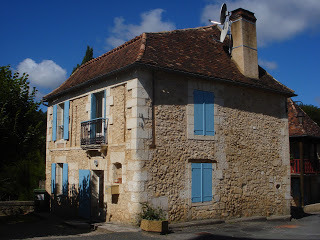 Maison dans Montclar
Maison dans MontclarAt 20 past ten last night the local farmer was still whizzing up and down with his tractor. They say they have long lunches in the middle of the day to avoid the heat, and yesterday was so very hot I think they’re sensible to do so.As you might have guessed, we didn’t go shopping yesterday morning. Instead we cycled east up the valley to St Laurent des Bâtons, another very pretty little village of 240 inhabitants with a Hotel de Ville, a church, a cemetery and not the slightest hint of a shop. They have a fair way to go for groceries. But then mileage, or should that be kilometreage? is strange here. We passed a signboard for Laurent: 0.1 kilometre. We rode another kikometre in the same direction toward Laurent and found a second signboard that declared it was still 0.1 of a kilometre to Laurent. Not quite a time warp, but certainly a mileage warp.
 MontclarMontclard, which we visited the day before yesterday, used to reign over ten parishes stretching from St Laurent des Batons in the east to Montagnac la Crempse in the west. Strangely, it never had a church – the hamlet of St Georges, a little further away, has the church, built on the site of a Gallo-Roman religious edifice. There is a footpath leading directly across the hill from Montclard to the church, but it must have been quite a trek of at least a kilometre on a cold winter’s day. Winters here can be surprisingly harsh. The winter of 2011/12 had days when the temperature dropped to minus 20 degrees C, and the bamboo, which a lot of keen gardeners employ as hedging these days, and all soft fruit along the valley, perished. Some of the trees look as if they’ve suffered, too.
MontclarMontclard, which we visited the day before yesterday, used to reign over ten parishes stretching from St Laurent des Batons in the east to Montagnac la Crempse in the west. Strangely, it never had a church – the hamlet of St Georges, a little further away, has the church, built on the site of a Gallo-Roman religious edifice. There is a footpath leading directly across the hill from Montclard to the church, but it must have been quite a trek of at least a kilometre on a cold winter’s day. Winters here can be surprisingly harsh. The winter of 2011/12 had days when the temperature dropped to minus 20 degrees C, and the bamboo, which a lot of keen gardeners employ as hedging these days, and all soft fruit along the valley, perished. Some of the trees look as if they’ve suffered, too.There used to be a chapel within the eleventh century castle walls, although recent excavations have yet to find any trace of it. It was called St Macaire’s Chapel. Montclard, which is confusingly spelled Montclar on the signboards and Montclard on the maps, has always been inhabited by lawyers, doctors, tradesmen and shopkeepers and, consequently, the village and its surroundings are notable for their lack of big, old farms. The ground floor of the large houses served as workshop, shop and depot. The baker is still there, and you have to be up early if you want to buy your bread fresh that day. By midday he’ll have shut up and gone home for ze long lunch.
BTW, if anyone knows what a rampeau is, do tell. There's one scheduled at the village fete on 28th. (Yes, I know fete should have those little triange thingies...)
Published on July 18, 2012 06:30
July 16, 2012
This is France
 The Castle looms up behind the housesAfter a grey weekend we woke to bright blue sky and sunshine, which is what we came to France to enjoy since we never get any at home. We’ve finished beating down the undergrowth and painting shutters, so this morning we took our bikes out on the road with serious intent.
The Castle looms up behind the housesAfter a grey weekend we woke to bright blue sky and sunshine, which is what we came to France to enjoy since we never get any at home. We’ve finished beating down the undergrowth and painting shutters, so this morning we took our bikes out on the road with serious intent.We cycled to Montclard St Georges which is about six miles away, and we went via country roads. Several times we stopped for a breather, or to let tractors go by and twice we had barking farm dogs run out at us. Fortunately the boxer gave up after a snarky look at me, a snarled Steady! discouraged the spaniel, and Non! turned away the one-eyed terrier. I don’t suppose the words mattered, and why I chose Steady! I’ll never know – the tone of command did the trick.
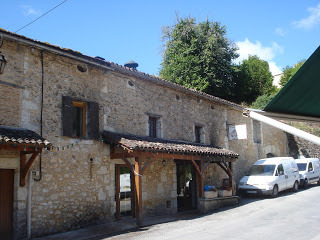 The bakeryThe castle at St Georges is still up for sale if anyone has a mind to buy. It’s been for sale for a year or two that we know of, but it seems there are no takers. I don’t know why – it’s set in the middle of a delightful village. Would take the deep pocket of a pop star, I suppose, to make something of it – but what a thing it would be! The little shop we'd planned to visit was closed due to the national holiday, which we'd sort of expected.Thinking of all the hills we’d laboured up, we opted to cycle back home via the main road, which wasn’t as scary as we anticipated. Drivers gave us a wide berth, possibly because in our high viz vests and definitely not in the first flush of youth, we looked dangerous on bikes with 20 inch wheels. I began to tire as we rode the last couple of miles home, but made it safely. The washing machine had done its job while we were out, so I hung the clothes out in the sunshine to dry, set up a tray and we ate pate and salad for lunch on the bolly. I plan not to move very far at all for the rest of the day, but we’re planning another road trip tomorrow. Or maybe we’ll go into Bergerac for much needed food supplies. We’ll decide in the morning.
The bakeryThe castle at St Georges is still up for sale if anyone has a mind to buy. It’s been for sale for a year or two that we know of, but it seems there are no takers. I don’t know why – it’s set in the middle of a delightful village. Would take the deep pocket of a pop star, I suppose, to make something of it – but what a thing it would be! The little shop we'd planned to visit was closed due to the national holiday, which we'd sort of expected.Thinking of all the hills we’d laboured up, we opted to cycle back home via the main road, which wasn’t as scary as we anticipated. Drivers gave us a wide berth, possibly because in our high viz vests and definitely not in the first flush of youth, we looked dangerous on bikes with 20 inch wheels. I began to tire as we rode the last couple of miles home, but made it safely. The washing machine had done its job while we were out, so I hung the clothes out in the sunshine to dry, set up a tray and we ate pate and salad for lunch on the bolly. I plan not to move very far at all for the rest of the day, but we’re planning another road trip tomorrow. Or maybe we’ll go into Bergerac for much needed food supplies. We’ll decide in the morning.
Published on July 16, 2012 05:52
July 13, 2012
France Fri 13th
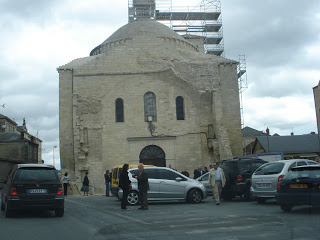 St.Etienne-de-la-Cite
St.Etienne-de-la-CitePerigueux is a city of thirty thousand people and a goodly percentage of them always seem to be out and about in the town. The good thing about this is that the traffic through the centre is oftn slow, which gives me time to take a pic or two. I took this pic of the old church, which was built in 1246 on the site of a Roman temple dedicated to Mars, as we skimmed by, and thought there may be a wedding in progress. Or maybe not. There are always tourists...
We reached the mill about 4.30 on Tuesday and since then we've done a lot of weeding house painting and hacking at the rampant undergrowth - not your average holiday, but we, sad souls that we are, enjoy it. I'm sitting in front of the window above the old mill stream, and admiring the luxuriant laurels, hazelnut and pine trees that completely enclose the view. Three dragon-flies, each a different colour, flit from leaf to leaf in the sunshine and occasionally a small bird darts in and out again. We've already seen a squirrel running along the fence outside the bedroom window, and a tiny wren found me fascinating as we peered at each other through the bathroom window. Then there are the lizards, though they're not really in evidence yet. They only creep out when the sun's shining, and so far, although the temperature is hovering about 20 degrees C, the sun and cloud keep swapping places.
We've done a "big shop" ie enough to keep us going for a few days and so now we can relax. Bill is painting - not the house this time, but an oil painting, and I'm torn between reading and doing some writing. The trouble is that our hosts are avid readers and always leave oodles of new and intersting books to read. The big Sunday supplements are here, too, and some of those are worth perusing. The other thing is that we haven't quite sorted the e-mail problem Between BT and Yahoo, I've been in limbo and doing anything on the old laptop I brought with me is a pain.I'm also very conscious of the fact that it is Friday 13th July! I could do it longhand, of course. Now wouldn't that be intersting?
Published on July 13, 2012 06:52
July 11, 2012
France 2012
Our holiday in France 2012 is underway.
 The pic may take a while to load and I apologise for that. I'm not using my own pc and things I usually do without thinking now take a lot of thought! The journey down was event free. We spent a couple of hours wandering Southsea at Portsmouth on Monday night while waiting for the ferry, and took pics of hovercraft and Southsea Castle. I didn't think of taking pics in France until we got to the fantastic bridge at Nantes but we were travelling too fast in the traffic stream to do it. When we reached Angouleme, I thought Isabella wouldn't recognise it now. The pic above was taken in one of the little towns between Angouleme and Brantome (and yes I know there should be a little half triangle above the vowels, but I haven't a clue where to find it on this pc) and is typical of the mix of ancient and modern, garish and elegant facades on any main thoroughfare of the region. I'll try and include more pics as I get to know this pc! Typically, the weather at the mill can’t make its mind up what it wants to do, but it is far warmer than it was back home, so that’s a boon. It’s midday and the indoor temperature is 19.5 degrees. Outside, it is warmer, especially in the sunshine. Trouble is, clouds have a nasty habit of sailing in from the west and immediately the temperature drops! We travelled approximately 700 miles to get here, but it is worth it.
The pic may take a while to load and I apologise for that. I'm not using my own pc and things I usually do without thinking now take a lot of thought! The journey down was event free. We spent a couple of hours wandering Southsea at Portsmouth on Monday night while waiting for the ferry, and took pics of hovercraft and Southsea Castle. I didn't think of taking pics in France until we got to the fantastic bridge at Nantes but we were travelling too fast in the traffic stream to do it. When we reached Angouleme, I thought Isabella wouldn't recognise it now. The pic above was taken in one of the little towns between Angouleme and Brantome (and yes I know there should be a little half triangle above the vowels, but I haven't a clue where to find it on this pc) and is typical of the mix of ancient and modern, garish and elegant facades on any main thoroughfare of the region. I'll try and include more pics as I get to know this pc! Typically, the weather at the mill can’t make its mind up what it wants to do, but it is far warmer than it was back home, so that’s a boon. It’s midday and the indoor temperature is 19.5 degrees. Outside, it is warmer, especially in the sunshine. Trouble is, clouds have a nasty habit of sailing in from the west and immediately the temperature drops! We travelled approximately 700 miles to get here, but it is worth it.
Published on July 11, 2012 05:45
July 8, 2012
Travelling south

This is an interim post only, because I am travelling south all day Monday 9th to catch the ferry from Portsmouth to St Malo in France. Tuesday we shall continue driving south, hopefully into sunshine, through Rennes, Nantes, Angouleme, then down to Perigeaux and our final destination near Bergerac. We're looking forward to seeing the sun in France. It's been so long since that glorious but unseasonal week in March....
The castle pictured on the right is Newcastle Keep, which is a fine example of a Norman keep. The website is:
http://www.castlekeepnewcastle.org.uk/keep_index.htm
Published on July 08, 2012 18:00
July 5, 2012
Warkworth Castle
 Warkworth, from the website
Warkworth, from the websiteJohn Goodall suggests in his giant book The English Castle that “about 1203, Warkworth Castle underwent a complete redevelopment. The bailey was entered through an imposing twin-towered gatehouse and possessed substantial residential buildings in stone.” The earl’s bed chamber was above the gatehouse.
The motte was probably crowned by a walled enclosure or shell keep, which was replaced about 1380 by a great tower of cut stone. The service, public and withdrawing chambers are lit by different forms of window, and the earl’s bedroom is marked externally by a sculpture of a rampant lion, the heraldic emblem of the family. It was almost certainly designed by John Lewyn, who worked on Durham Cathedral in 1353 and was responsible for the great kitchen with its fine star vault. In 1368 he worked on Bamburgh Castle, and probably oversaw the erection of the Neville screen in the Cathedral in 1380. The screen was designed and built in London from Caen stone and shipped to Durham via Newcastle, and probably gave Lewyn the idea for the decorative crown of the great tower and watch tower at Warkworth.
The tower forms a Greek cross with four polygonal wings radiating from the central block. (In simple terms, imagine a small square surrounded by a larger square. Then visualise four small squares projecting outwards, one from each of the four sides of the larger square.) It was planned using a unit of measurement sometimes called a rod, a pole or a perch – 16feet six inches.
In 1471 Henry Percy, Earl of Northumberland, ordered another re-organisation. Splendid porch towers were built over the hall and great chamber, the one over the hall bearing the modern and ancient arms of the family. The masons involved had also worked on York Minster. Work was interrupted by the murder of the earl in 1489. It seems the earl’s decision not to commit to the Battle of Bosworth until a winner had emerged so disgusted his household that they abandoned him to a mob during a tax riot.
The main entrance was through the tower porch, decorated with family heraldry. The hall was divided by an arcade and there was an adjoining building with service and lodging chambers at its low end. Two stairs at the opposite end of the hall gave access to the great chamber, which was enclosed within a second tower porch that also gave access via stairs to the courtyard. There was an upper chamber above the great chamber, at the level of the hall roof, possible a banqueting chamber. The household chapel stood at right angles to the hall range and had a large balcony or closet that opened off the great chamber and overlooked the chapel.For more information, try the website: Warkworth
Published on July 05, 2012 18:00
July 3, 2012
Heat and Light
Fireplaces have been found in English castles as early as 1081, but they were unlike modern fireplaces in that they projected out into the room they heated, and they didn’t have a chimney. The smoke escaped through small holes in the external wall at the back.
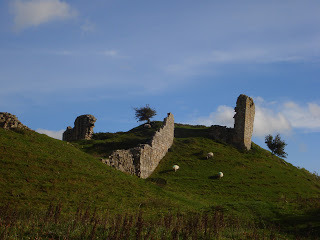 HarbottleBy the early twelfth century builders had devised a flue that carried smoke to an external chimney on the roof. By the fourteenth century fireplaces lost their projecting hoods and were recessed into the wall, usually on a long wall, and often off-centre, so they were closer to the “higher” end of the hall. In France, the practice was to place the fireplace behind the dais. Decoration included abstract patterns cut into the stone in the twelfth century and heraldry in the later middle ages. The decoration of fireplaces never transferred to internal doorways in English architecture, possibly because wall hangings and tapestries often obscured doorways. In direct contrast, the French habit, commonplace by the fifteenth century, was to extensively decorate door mouldings.
HarbottleBy the early twelfth century builders had devised a flue that carried smoke to an external chimney on the roof. By the fourteenth century fireplaces lost their projecting hoods and were recessed into the wall, usually on a long wall, and often off-centre, so they were closer to the “higher” end of the hall. In France, the practice was to place the fireplace behind the dais. Decoration included abstract patterns cut into the stone in the twelfth century and heraldry in the later middle ages. The decoration of fireplaces never transferred to internal doorways in English architecture, possibly because wall hangings and tapestries often obscured doorways. In direct contrast, the French habit, commonplace by the fifteenth century, was to extensively decorate door mouldings.
Lighting was difficult in castles. Most light sources were portable, either suspended as chandeliers of wood, brass or iron. Small wall niches are found in stone walls of corridors and latrines. Lamps could be mounted on projecting brackets in smaller chambers, usually to either side of the fireplace.
Of course, like everything else, there are castles, and castles. The big ones, like Warkworth in Northumberland, had sophisticated living areas, but small castles at the business end of things, like Harbottle, also in Northumberland and much closer to the border with Scotland, had few amenities. I’ve talked about Harbottle before on this blog but not about Warkworth. I’ll save that for the next post.
 HarbottleBy the early twelfth century builders had devised a flue that carried smoke to an external chimney on the roof. By the fourteenth century fireplaces lost their projecting hoods and were recessed into the wall, usually on a long wall, and often off-centre, so they were closer to the “higher” end of the hall. In France, the practice was to place the fireplace behind the dais. Decoration included abstract patterns cut into the stone in the twelfth century and heraldry in the later middle ages. The decoration of fireplaces never transferred to internal doorways in English architecture, possibly because wall hangings and tapestries often obscured doorways. In direct contrast, the French habit, commonplace by the fifteenth century, was to extensively decorate door mouldings.
HarbottleBy the early twelfth century builders had devised a flue that carried smoke to an external chimney on the roof. By the fourteenth century fireplaces lost their projecting hoods and were recessed into the wall, usually on a long wall, and often off-centre, so they were closer to the “higher” end of the hall. In France, the practice was to place the fireplace behind the dais. Decoration included abstract patterns cut into the stone in the twelfth century and heraldry in the later middle ages. The decoration of fireplaces never transferred to internal doorways in English architecture, possibly because wall hangings and tapestries often obscured doorways. In direct contrast, the French habit, commonplace by the fifteenth century, was to extensively decorate door mouldings.Lighting was difficult in castles. Most light sources were portable, either suspended as chandeliers of wood, brass or iron. Small wall niches are found in stone walls of corridors and latrines. Lamps could be mounted on projecting brackets in smaller chambers, usually to either side of the fireplace.
Of course, like everything else, there are castles, and castles. The big ones, like Warkworth in Northumberland, had sophisticated living areas, but small castles at the business end of things, like Harbottle, also in Northumberland and much closer to the border with Scotland, had few amenities. I’ve talked about Harbottle before on this blog but not about Warkworth. I’ll save that for the next post.
Published on July 03, 2012 18:00
July 1, 2012
News Break
A short interim post because I'm travelling south today. We are off to Portsmouth to catch the overnight ferry to St Malo in France. Then most of Tuesday we'll be driving south hopefully into the sunshine through Rennes, Nantes, Angouleme and then perhaps across to Poitiers or maybe straight down the motorway until we reach a turn off that will take us across minor roads towards Vergt, From there, its about 15 miles to the mill. We'll decide at some point!
Published on July 01, 2012 18:00
Necessities of life in castles
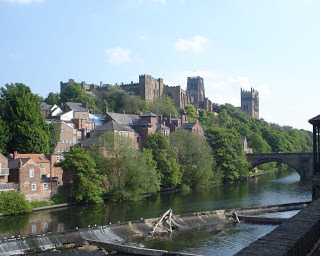 Durham Castle and Cathedral above the river WearLatrines are usually called garderobes in historical fiction, but they had other names – Gang, or gong, cloacum, neccessarium, reredorter and jake, which is the French form of john or jonny. The Welsh tŷ bach was also used (it means a small or private place). Another popular name was the privy.
Durham Castle and Cathedral above the river WearLatrines are usually called garderobes in historical fiction, but they had other names – Gang, or gong, cloacum, neccessarium, reredorter and jake, which is the French form of john or jonny. The Welsh tŷ bach was also used (it means a small or private place). Another popular name was the privy.Priviesvaried from a hole in the ground to grand, purpose built structures – a wooden bench with a hole cut into it, or sometimes stone seats, inside a small, private space. Lids with handles were used to drop across the hole, and earth or sand was kept to throw in; both required in an effort to dampen the smells. Henry VIII had sand in his jake at Dover Castle. Gongscouring was a recognised trade by the 16th century. I can't help but shudder at the thought of a stone toilet seat on a frosty January morning...
Usually the latrine cubicle projected out over the castle walls, and excrement piled up below. Someone (the gongscourer) had to go around at frequent intervals and shift it. Sometimes a chute or shaft inside the walls drained into a cesspit. In this case, latrines were necessarily grouped together at one spot in the castle. Rainwater was often directed from rooftops to the chutes to clean them out. Hampton Court had a communal House of Easement which was two stories high. “Pissing places” were common and at Greenwich Palace an effort was made to stop this habit by whitening the walls and painting red crosses on them in the belief that no Christian would piss against the Holy Cross.
From the 15th century on, toilet arrangements within private chambers featured a chair or stool with a pot included below the seat – a close stool – and the pot would be regularly cleaned out by servants. (I imagine they emptied the contents over the castle walls! Certainly that happened at Stirling Castle in the sixteenth century.)
Water was a necessity for life within the castle and several wells were included at most residences. The deepest well in England goes down 330 feet, (100 metres) and such depth requires a mechanism to lift the heavy bucket full of water to the surface. Systems of pulleys and counter balances were used. Rainwater was also stored in cisterns at roof level and lead pipes were in use from 1300.
Published on July 01, 2012 18:00
June 28, 2012
Castle Interiors
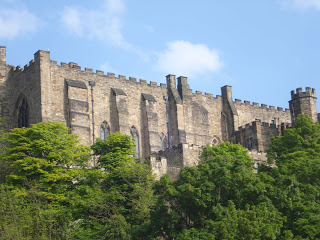 Durham Castle from the riverside
Durham Castle from the riversideThe typical nobleman’s house contained kitchens, communal space, withdrawing rooms and a chapel. In the early days, they may have been housed in separate buildings, but by the 12th century the separate parts began to come together in one building.
The Great Hall had services (ie kitchen, pantry, buttery) at one end and the withdrawing space (ie one withdrew from the hall into a private space) at the other. The Great Hall goes back into legend – Beowulf awaited Grendel in the Great Hall. Built of timber, with a huge open timber roof – ie no upper storey, the halls were built on the same plan for a thousand years, in differing scales and in every form of dwelling. Gradually homes expanded and life went out of great halls and into withdrawing spaces, but we still have a hall, which is the space a visitor first sees on entering our homes today.
In the middle ages, the entrance to the hall was through a porch in one of the long sides of the hall, and then visitor a “screens passage” to the hall. Timber screens or partitions on one side of the corridor closed off the view of the hall. Two doors led from the passage to the “low status” end of the hall; on the other side of the passage, there would be three doors – one to the kitchen, another to the pantry and the third into the buttery.
A step ran across the width of the hall and separated the nobility from the hoi polloi. At the end furthest from the screens passage, beyond the step, was a raised dais at the “high” end of the hall. After the fourteenth century it was often lit by a projecting bay or an oriel window. Behind the dais a door led to the withdrawing chambers beyond. The open fireplace was in the centre of the hall, and smoke escaped via an opening in the roof. Fireplaces were common in other dwellings by the fourteenth century, but halls persisted with the central hearth.
Trestle tables, set lengthwise along the walls, were set up for meals while the head of the household sat at a single high table that ran across the width of the dais. There would be several “sittings” for meals in large households, and by the fourteenth century the head of the house most likely ate in his withdrawing chamber.
Published on June 28, 2012 18:00
Jen Black's Blog
- Jen Black's profile
- 6 followers
Jen Black isn't a Goodreads Author
(yet),
but they
do have a blog,
so here are some recent posts imported from
their feed.



